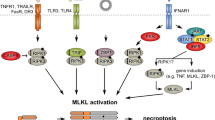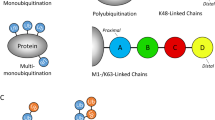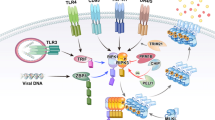Abstract
Recently, several tumor necrosis factor receptor 1 (TNF-R1) and Fas-related death receptors have been discovered and include DR3, DR4, DR5 and DR6. These receptors contain an extracellular region containing varying numbers of cysteine-rich domains and an intracellular region that contains the death domain. The death receptors are activated in a ligand-dependent or independent manner and transduce apoptotic signals via their respective intracellular death domains. In addition to death receptors, several decoy molecules have also been identified and include DcR1/TRID, DcR2/TRUNDD, DcR3 and osteoprotegrin (OPG). The decoy molecules do not transduce apoptotic signals but rather compete with the death receptors for ligand binding and thereby inhibit ligand-induced apoptosis. Recent evidence suggests that p53 upregulates the expression of death receptors Fas and DR5, and thus, may mediate apoptosis in part via Fas and/or DR5. However, p53 also regulates the expression of TRAIL decoy receptors DcR1/TRID and DR2/TRUNDD. Although the significance of p53-dependent regulation of decoy receptors remains unclear, evidence suggests that DcR1/TRUNDD appears to inhibit 53-mediated apoptosis. It is, therefore, possible that p53 may blunt its DR5-dependent apoptotic effects by controlling the levels of decoy receptors.
This is a preview of subscription content, access via your institution
Access options
Subscribe to this journal
Receive 12 print issues and online access
$259.00 per year
only $21.58 per issue
Buy this article
- Purchase on Springer Link
- Instant access to full article PDF
Prices may be subject to local taxes which are calculated during checkout



Similar content being viewed by others
References
Nagata S . Apoptosis by death factor Cell 1997 88: 355–365
Askkenazi A, Dixit VM . Apoptosis control by death and decoy receptors Curr Opin Cell Biol 1999 11: 255–260
Hsu H, Xiong J, Goeddel DV . The TNF receptor 1-associated protein TRADD signals cell death and NF-kappa B activation Cell 1995 81: 495–504
Chinnaiyan AM, O'Rourke K, Tewari M, Dixit VM . FADD, a novel death domain-containing protein, interacts with death domains of Fas and initiates apoptosis Cell 1995 81: 505–572
Boldin MP, Goncharov TM, Goltsev YV, Wallach D . Involvement of MACH, a novel MORT1/FADD-interacting protease, in Fas/APO-1- and TNF receptor-induced cell death Cell 1996 85: 803–815
Wang E, Marcotte R, Petroulakis E . Signaling pathway for apoptosis: a racetrack for life or death J Cell Biochem 1999 32/33: 95–102
Kelliher MA, Grimm S, Ishida Y, Kuo F, Stanger BZ, Lede P . The death domain kinase RIP mediates the TNF-induced NF-κB signal Immunity 1998 8: 297–303
Jiang Y, Woronicz JD, Liu W, Goeddel DV . Prevention of constitutive TNF receptor 1 signaling by silencer of death domain Science 1999 283: 543–546
Wang C-Y, Mayo MW, Korneluk RG, Goeddel DV, Baldwin AS . NF-κB antiapoptosis induction of TRAF1 and TRAF2 and c-IAP1 and c-IAP2 to suppress caspase 8 activation Science 1999 281: 1680–1683
Baker SJ, Reddy EP . Modulation of life and death by the TNF receptor supferfamily Oncogene 1998 17: 3261–3270
Yang X, Khosravi-Far R, Chang HY, Baltimore D . Daxx, a novel Fas-binding protein that activates JNK and apoptosis Cell 1997 89: 1067–1076
Chang HY, Nishitoh H, Yang X, Ichijo H, Baltimore D . Activation of apoptosis signal-regulating kinase 1 (ASK1) by the adapter protein Daxx Science 1998 281: 1860–1863
Chinnaiyan AM, O'Rourke K, Yu G-L, Lyons RH, Garg M, Duan DR, Xing L, Gentz R, Ni J, Dixit VM . Signal transduction by DR3, a death domain-containing receptor related to TNFR-1 and CD95 Science 1996 274: 990–992
Bodmer J-L, Burns K, Schneider P, Hofmann K, Steiner V, Thome M, Bonard T, Hahne M, Schroter M, Becker K, Wilson A, French LE, Browing JL, Macdonald HR, Tschopp J . TRAMP, a novel apoptosis-mediating receptor with sequence homology to tumor necrosis factor receptor 1 and Fas (Apo-1/CD95) Immunity 1997 6: 79–105
Marsters SA, Sheridan JP, Pitti RM, Brush J, Goddard AD, Ashkenazi A . Identification of a ligand for the death-domain-containing receptor Apo3 Curr Biol 1998 8: 525–528
Degli-Esposti M . To die or not to die – the quest of the TRAIL receptors J Leuk Biol 1999 65: 535–542
Yeh WC, Pompa JL, McCurrach ME, Shu HB, Elia AJ, Shahinian A, Ng M, Wakeham A, Khoo W, Mitchell K, El-Deiry WS, Lowe SW, Goeddel DV, Mak TW . FADD: essential for embryo development and signaling from some, but not all, inducers of apoptosis Science 1998 279: 1954–1958
Jeremias I, Debatin KM . TRAIL induces apoptosis and activation of NF-kappa B Eur Cytokine Netw 1998 9: 687–688
Hu WH, Johnson H, Shu HB . Tumor necrosis factor-related apoptosis-inducing ligand receptors signal NF-kappa B and JNK activation and apoptosis through distinct pathways J Biol Chem 1999 274: 30603–30610
Pan G, Baurer JH, Haridas V, Wang S, Liu D, Yu G, Vincenz C, Aggrwal BB, Ni J, Dixit VM . Identification and functional characterization of DR6, a novel death domain-containing TNF receptor FEBS Lett 1998 431: 351–356
Pan G, Ni J, Wei Y-F, Yu G-L, Gentz R, Dixit VM . An antagonist decoy receptor and a death domain-containing receptor for TRAIL Science 1997 277: 815–818
Degli-Esposti MA, Smolak PJ, Walczak H, Waugh JY, Huang C-P, DuBose, RF, Goodwin RG, Smith CA . Cloning and characterization of TRAIL-R3, a novel member of the emerging TRAIL receptor family J Exp Med 1997 186: 1165–1170
Sheridan JP, Marsters SA, Pitti RM, Gurney A, Skubatch M, Baldwin D, Ramakrishnan L, Gray CL, Baker K, Wood WI, Goddard AD, Godowski P, Ashkenazi A . Control of TRAIL-induced apoptosis by a family of signaling and decoy receptors Science 1997 277: 818–821
Pan G, O'Rourke K, Chinnaiyan AM, Ebner R, Ni J, Y-F, Dixit VM . TRUNDD, a new member of the TRAIL receptor family that antagonizes TRAIL signaling FEBS Lett 1998 424: 41–45
Degli-Esposti MA, Dougall WC, Smolak PJ, Waugh JY, Smith CA, Goodwin RG . The novel receptor TRAIL-R4 induces NFkB and protects against TRAIL-mediated apoptosis, yet retains an incomplete death domain Immunity 1997 7: 813–820
Marsters SA, Sheridan JP, Pitti RM, Huang A, Skubatach M, Baldwin D, Yuan J, Gurney A, Goddard AD, Godowski P, Ashkenazi A . A novel receptor for Apo2L/TRAIL contains a truncated death domain Curr Biol 1997 7: 1003–1006
Pitti RM, Marsters SA, Lawrence DA, Roy M, Kischkel FC, Dowd P, Huang A, Donahue CJ, Sherwood SW, Baldwin DT, Godowski PJ, Wood WI, Gurney AL, Hillan KJ, Cohen RL, Goddard AD, Botstein D, Ashkenazi A . Genomic amplification of a decoy receptor for Fas ligand in lung and colon cancer Nature 1998 396: 699–703
Simonet WS, Lacey DL, Dunstan CR, Kelley M, Chang MS, Luthy R, Nguyen HQ, Wooden S, Bennett L, Boone T, Shimamoto G, DeRose M, Elliott R, Colombero A, Tan HL, Trail G, Sullivan J, Davy E, Bucay N, Renshaw-Gegg L, Hughes TM, Hill D, Pattison W, Campbell P, Boyle WJ . Osteoprotegerin: a novel secreted protein involved in the regulation of bone density Cell 1997 89: 309–319
Ko LJ, Prives C . p53: puzzled and paradigm Genes Dev 1996 10: 1054–1072
El-Deiry WS . Regulation of p53 downstream genes Semin Cancer Biol 1998 8: 345–357
Gottlieb TM, Oren M . p53 and apoptosis Semin Cancer Biol 1998 8: 359–368
Giaccia AJ, Kastan MB . The complexity of p53 modulation: emerging patterns from divergent signals Genes Dev 1998 12: 2973–2983
Sheikh MS, Fornace AJ Jr . Role of p53-family members in apoptotis J Cell Physiol 2000 182: 171–181
Haupt Y, Rowan S, Shaulian E, Vousden KH, Oren M . Induction of apoptosis in HeLa cells by trans-activation-deficient p53 Genes Dev 1995 9: 2170–2183
Caelles C, Helmberg A, Karin M . p53-dependent apoptosis in the absence of transcriptional activation of p53-target genes Nature 1994 370: 220–223
Friesen C, Herr I, Krammer PH, Debatin KM . Involvement of the CD95 (APO1/Fas) receptor/ligand system in drug-induced apoptosis in leukemia cells Nature Med 1996 2: 574–577
Muller M, Wilder S, Bannasch D, Israeli D, Lehlbach K, Li-Weber M, Friedmann SL, Galle PR, Stremmel W, Oren M, Krammer PH . p53 activates the CD95 (APO1/Fas) gene in response to DNA damage by anticancer drugs J Exp Med 1998 188: 2033–2045
Owen-Schaub LB, Zhang W, Cusack JC, Angelo LS, Santee SM, Fujiwara T, Roth JA, Deisseroth AB, Zhang W-W, Kruzel E, Radinsky R . Wild-type p53 and a temperature sensitive mutant induce Fas/APO-1 expression Mol Cell Biol 1995 15: 3032–3040
Wu GS, Burns TF, McDonald III ER, Jiang W, Meng R, Krantz ID, Kao G, Gan DD, Zhou J-Y, Muschel R, Hamilton SR, Spinner NB, Markowitz S, Wu G, El-Deiry WS . KILLER/DR5 is DNA damage-inducible p53-regulated death receptor gene Nat Genet 1997 17: 141–143
Sheikh MS, Burns TF, Huang Y, Wu GS, Amundson S, Brooks KS, Fornace AJ Jr, El-Deiry WS . p53-dependent and independent regulation of the death receptor KILLER/DR5 gene expression in response to genotoxic stress and TNFα Cancer Res 1998 58: 1593–1598
Sheikh MS, Huang Y, Fernandez-Salas E, El-Deiry WS, Amundson S, Friess H, Yin J, Meltzer SJ, Holbrook NJ, Fornace AJ Jr . The antiapoptotic decoy receptor TRID/TRAIL-R3 is a p53-regulated DNA damage-inducible gene that is overexpressed in primary tumors of gastrointestinal tract Oncogene 1999 18: 4153–4159
Meng RD, McDonald III ER, Sheikh MS, Fornance AJ Jr, El-Deiry WS . The TRAIL decoy receptor TRUNDD (DcR2, TRAIL-R10 is induced by denovirus-p53 overexpression and can delay TRAIL-, p53-, and KILLER/DR5-dependent colon cancer apoptosis Mol Therapy 2000 1: 130–143
Mo Y-Y, Beck WT . DNA damage signals induction of Fas ligand in tumor cells Mol Pharmacol 1999 55: 216–222
Bennett M, Macdonald K, Chan S-W, Luzio JP, Simari R, Weissberg P . Cell surface trafficking of Fas: a rapid mechanism of p53-mediated apoptosis Science 1998 274: 1363–1366
Fuchs EJ, McKenna KA, Bedi A . p53-dependent DNA damage-induced apoptosis requires Fas/APO-1-independent activation of CPP32 Cancer Res 1997 57: 2550–2554
Ruiz-Ruiz MC, Lopez-Rivas A . p53-mediated up-regulation of CD95 is not involved in genotoxic drug-induced apoptosis of human breast tumor cells Cell Death Differ 1999 6: 271–280
Miyashita T, Reed JC . Tumor suppressor p53 is a direct transcriptional activator of the human bax gene Cell 1995 80: 293–299
Zhan Q, Alamo I, Yu K, Boise LH, Cherney B, Tosato G, O'Connor PM, Fornace AJ Jr . The apoptosis-associated gamma-ray response of BCL-XL depends on normal p53 function Oncogene 1996 13: 2287–2293
Reed JC . Bcl-2 family proteins Oncogene 1998 17: 3225–3236
Author information
Authors and Affiliations
Rights and permissions
About this article
Cite this article
Sheikh, M., Fornace, A. Death and decoy receptors and p53-mediated apoptosis. Leukemia 14, 1509–1513 (2000). https://doi.org/10.1038/sj.leu.2401865
Received:
Accepted:
Published:
Issue Date:
DOI: https://doi.org/10.1038/sj.leu.2401865
Keywords
This article is cited by
-
Regulation of anoikis by extrinsic death receptor pathways
Cell Communication and Signaling (2023)
-
TRAIL receptor-induced features of epithelial-to-mesenchymal transition increase tumour phenotypic heterogeneity: potential cell survival mechanisms
British Journal of Cancer (2021)
-
Ferroptosis, radiotherapy, and combination therapeutic strategies
Protein & Cell (2021)
-
Ischemic tolerance modulates TRAIL expression and its receptors and generates a neuroprotected phenotype
Cell Death & Disease (2014)
-
Combination of Albendazole and 2-Methoxyestradiol significantly improves the survival of HCT-116 tumor-bearing nude mice
BMC Cancer (2013)



